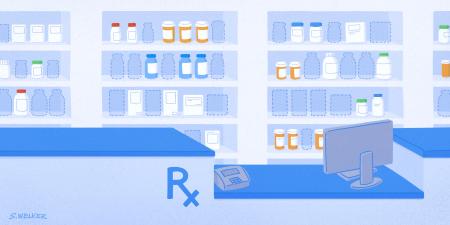Abstract
Reliable, adequate supply of essential items, including quality-assured medicines, is hard to maintain in refugee camps in low- and middle-income countries. Disruption of medicine supply chains delays treatment for displaced persons and drives procurement of poor-quality products, often from unauthorized or unlicensed sellers. This article explains how current strategies and policies disrupt reliable flow of safe medicines to refugee camps and calls on stakeholders to rigorously map medicine supply chains to refugee camps, which would help identify strategies to improve displaced persons’ access to quality-assured medicines.
Refugee Health
Refugee health is a global public health priority.1,2 The United Nations Refugee Agency (UNHCR) recently reported that, at the end of 2022, there were over 35 million refugees worldwide and over 100 million people forcibly displaced globally.3 Forcibly displaced communities frequently use health systems with inadequate capacity to diagnose and manage both communicable and noncommunicable illnesses. Additionally, supply of essential items, including quality-assured medicines, has been difficult to maintain in refugee camps, often due to cuts in aid and ongoing conflict and political unrest.4,5,6,7 Medicine supply chain disruption can result in interrupted treatments of chronic illnesses,1 irrational medicine usage (especially for communicable diseases), and patients utilizing private, unauthorized, or unlicensed vendors,7,8,9 who might sell poor-quality medicines or medicines at increased prices.10 These poor-quality medicines might be substandard—that is, authorized products that fail to meet quality specifications—or falsified by deliberately misrepresenting their identity.11 Poor-quality medicines can lead to immediate treatment failure or have longer-term consequences, such as antimicrobial resistance development in the case of poor-quality antibiotic usage.12 Research has shown that poor-quality antimicrobial medicines continue to proliferate in low- and middle-income countries (LMICs),13 including in and around refugee camps.14 Procurement and supply of medicines for displaced populations, however, is complex, given constantly evolving environments.
Here, we discuss the risks of poor-quality medicines being procured for refugee camps in LMICs as a result of both regulated and informal procurement strategies and streams. It should be noted that our discussion of refugees might be less applicable to internally displaced persons and urban informal settlements. Awareness of and striving to improve refugee health is an important moral imperative for clinicians and health care students, given the increase of conflict and climate change, both of which cause displacement. Because the effects of forced displacement are also global, increased global awareness of complex issues helps prepare health care workers and students to be more empathetic, thoughtful, and better prepared for challenges in caring for diverse communities.
How Regulated Medicine Procurement Might Compromise Medicine Quality
Regulated (official) procurement and distribution of medicines for refugees is generally done via international and local humanitarian organizations and nongovernmental organizations (NGOs). For example, UNHCR uses a competitive bidding process to procure medicines from international vendors, in which requests for bids—typically for a proactive 12-month supply—are posted and different suppliers bid.15,16 Medicines are purchased using the “best-value quality” criteria.15 Within this system, quality assurance is meant to be built in with certification of the manufacturer’s good manufacturing practices and audits of the supplier’s distribution and storage practices.15 However, many steps must occur before medicines reach refugees, especially with international procurement. These steps include medicine list and budget approval, quality assurance, preclearance for import, medicine availability, customs, taxes, and having distribution in place, to name a few.15 As a result, there might be a delay of many months before medicines are received.16 For example, a medicines shipment was held for 4 months in Jordan because of high customs duty, with the result that the drugs expired.17 Deterioration of medicine quality can arise from prolonged delays in import or customs clearance, potentially causing extended periods of poor storage conditions (eg, exposure to heat, sunlight, humidity) and consequent expiration of drugs. Additionally, medicine requests are typically based on historical consumption data,15 which can promote existing patterns of irrational medicine use among refugees.18,19 Examples include using medicines not prescribed in accordance with clinical guidelines, self-medication (often of prescription-only medicines), and inappropriate use of antimicrobials to treat nonbacterial infections.18 Once UNHCR procures medicines, they are typically distributed by partners. Importantly, warehouses and storage facilities must have appropriate storage conditions to prevent medicine degradation.
Deviation from procurement policies is sometimes necessary. While it is UNHCR’s policy to bid and purchase medical products through international suppliers to ensure quality,15 some countries are requiring that medicines be procured locally.16,20 This policy might decrease lead times, but local regulatory authorities might not be as strict about quality assurance. Many international organizations discourage medicine donations due to concerns about expiration or mishandling. During emergencies, however, there are limited options, and, as such, specific guidelines for donations should be followed.21 Access to medicines from aid organizations at official organization facilities might also be dependent on legal refugee status.
However, from our correspondence with humanitarian organizations and those who have worked in the field, it emerges that there are often numerous organizations involved in procurement and distribution within a specific camp or geographical area, as well as unauthorized or unlicensed vendors that form informal routes of supply. Thus, the true nature of the medicine supply chain in refugee camps is not transparent. Furthermore, the role of local governments and national health regulatory authorities, especially in quality assurance, is unclear.
Informal Procurement
While regulated procurement strategies attempt to ensure quality of procured medicines, informal22 and multiple flows of medicines into refugee camps introduce additional risks of poor quality and irrational consumption (eg, self-medication and misuse of prescription-only medicines). There might be multiple organizations supplying medicines to refugees that do not adhere to strict requirements for international procurement, as do larger NGOs. Moreover, smaller organizations that might have their own warehouses—or use those of larger organizations—to store medicines might fail to follow good storage practices or lack the resources to do so. In addition, some organizations procure specialized medicines or have agreements with local distributors that might procure medicines both internationally and locally, which makes it harder to trace and verify quality assurance. However, local distributors can allow for shorter lead times when more medicines are needed. Officially procured medicines intended for refugees might also be leaked onto the unofficial market.
In instances of conflict, there have even been reports of health care and aid workers teaming up with smugglers to provide needed medical supplies during shortages.
Medicines can be procured informally in a number of ways. Medicines directly provided by family and friends visiting the camps can enter the supply chain.6 Within refugee camps, especially long-established camps, there are often unregulated informal pharmacies and outlets. These outlets might carry smuggled medicines or medicines supplied unofficially from local distributors.8 In instances of conflict, there have even been reports of health care and aid workers teaming up with smugglers to provide needed medical supplies during shortages,23 which raises the question of whether no medicines or bad medicines is more harmful. Alarmingly, there are increasing reports of smuggling of controlled substances into refugee camps, putting an already vulnerable population at further risk.24 Taken together, the medicine supply chain is much more complex than what is defined by documented or regulated procurement practices.
Recommendations
We have a global responsibility to protect refugee health, which includes ensuring supply of and access to quality-assured medicines.1 To root out medicine quality issues and implement quality assurance along the supply chain and add resilience, we recommend taking the following steps.
Call for rigorous supply chain mapping in refugee camps. Given the complex flow of medicines into refugee camps and the lack of accessible information, we call for formal reports that rigorously (quantitatively and qualitatively) map the medicine supply chain in refugee camps to determine and document all inflow channels of medicines, including regulated and informal procurement and distribution and how responsibility is allocated. Such a project might be difficult for academic institutions to undertake alone and will require buy-in and support from governments and international organizations. Due to supply chains’ complexity, initial mapping studies would likely focus on specific camps and geographies.
The findings of such a report are critical for identifying problems related to medicine quality and supply and would help strengthen policies for procurement and quality assurance of medicines intended for use in displaced populations. For example, although smuggled or unofficially supplied medicines might raise quality concerns, the extent of their market share must first be determined. This information can inform strategies to ensure an adequate supply of quality-assured medicines before considering removal of smuggled or unofficially supplied medicines from the supply chain. Data from mapping reports could also be used to implement specific interventions for quality assurance along multiple points and among multiple players within the supply chain, promote increased transparency, and reduce supply chain leaks. The World Health Organization recently commissioned a series of reports on health and migration, highlighting refugee health as an emerging priority area.2
Strengthen local and regional manufacturing to diversify the supply chain. Procurement by NGOs is largely international due to concerns about limited local manufacturing and quality. Strengthening regional and local manufacturing programs could add resiliency to the supply chain and reduce delays due to transportation and customs clearance, especially during unexpected public health emergencies.25 Such efforts would require international and local cooperation and continued capital investment, including health systems and regulatory authority strengthening, technical capacity building, and strengthened coupling of regional manufacturing and distribution chains. However, strengthening regional and local manufacturing programs can promote global supply chain resilience, along with human and economic capital development. Challenges of building local manufacturing capacity include not only meeting demand, but also ensuring manufacturers’ adherence to international good manufacturing and quality control practices that differ from those of national authorities. Incentives or rewards in the form of a commitment to purchase for ensuring quality and fines for not adhering to quality assurance guidelines might be strategies to build capacity. As it might be difficult for local manufacturers to initially be cost-effective, split tender awards might be a solution. Additionally, factors such as taxation26 and lead times might be integrated into the best-value quality strategy. Quantifying economic development and benefits such as human capital development that support a higher price premium for quality-assured locally produced medicines might also be necessary.
Conclusion
Overall, the true nature of the medicine supply chain in refugee camps in LMICs is not well documented, leading to gaps in knowledge about medicine quality, consumption patterns, and refugee health outcomes. While we have focused primarily on the medicine supply chain, effective and rational procurement must be integrated with robust health service delivery that refugees trust. We also note that striking a balance between humanitarian aid to refugees and adequate supply to citizens when medicine shortages might exist for both populations will require further analysis, especially when local governments are involved. Delivering health care and medicines more broadly in active conflict zones is another important challenge that requires additional attention and consideration due to the practical realties on the ground. As a global community, we cannot accept refugees’ use of inappropriate medicines or medicines of questionable quality and must ensure their access to quality-assured medicines. To do so will require rigorous mapping studies, supply chain strengthening, and coordination between governments and multiple agencies.
References
-
Syed Q, Mobayed T. Who is responsible for the health care of refugees? Lancet. 2017;389(10081):1793.
-
Newly launched WHO GEHM series marks a milestone in starting a systematic evidence review in key topical issues on health and migration. World Health Organization. June 17, 2021. Accessed December 19, 2023. https://www.who.int/news/item/17-06-2021-newly-launched-who-gehm-series-marks-a-milestone-in-starting-a-systematic-evidence-review-in-key-topical-issues-on-health-and-migration
-
Figures at a glance. UNHCR: UN Refugee Agency. Accessed December 19, 2023. https://www.unhcr.org/us/about-unhcr/who-we-are/figures-glance
-
RFA Burmese. Refugee camps short of food, medicine in Myanmar’s Kayah State. Radio Free Asia. August 5, 2022. Accessed December 19, 2023. https://www.rfa.org/english/news/myanmar/camps-08052022144100.html
-
Refugees worldwide face rising hunger due to funding gaps amidst Covid-19. World Food Programme. June 18, 2021. Accessed December 19, 2023. https://www.wfp.org/news/refugees-worldwide-face-rising-hunger-due-funding-gaps-amidst-covid-19
- Tresànchez-Lacorte B, Figueras A. Medicines in Western Sahara refugee camps in Tindouf: prescriptions and self-medication mixing in the drawer. Glob Public Health. 2020;15(12):1871-1877.
-
Refugees complain of shortages of medicines in Boro Medina camp. Radio Tamazuj. August 25, 2014. Accessed December 19, 2023. https://radiotamazuj.org/en/news/article/refugees-complain-of-shortages-of-medicines-in-boro-medina-camp
-
Nashed M. Palestinian refugees struggle with drugs. Aljazeera. August 30, 2014. Accessed December 19, 2023. https://www.aljazeera.com/news/2014/8/30/palestinian-refugees-struggle-with-drugs
-
Drugs worth 63 million shillings impounded in refugee camp. Unlicensed clinics and non qualified health providers are behind it. Cross-Border Network. October 10, 2019. Accessed December 19, 2023. https://crossbordernet.org/national-drug-authority-impounds-drugs-worth-63-million-shillings-unlicensed-clinics-and-non-qualified-health-providers-are-behind-it/
-
Pisani E, Nistor AL, Hasnida A, Parmaksiz K, Xu J, Kok MO. Identifying market risk for substandard and falsified medicines: an analytic framework based on qualitative research in China, Indonesia, Turkey and Romania. Wellcome Open Res. 2019;4:70.
-
World Health Organization. A Study on the Public Health and Socioeconomic Impact of Substandard and Falsified Medical Products. World Health Organization; 2017. Accessed December 19, 2023. https://apps.who.int/iris/bitstream/handle/10665/331690/9789241513432-eng.pdf?sequence=1&isAllowed=y
-
Ching C, Zaman MH. Development and selection of low-level multi-drug resistance over an extended range of sub-inhibitory ciprofloxacin concentrations in Escherichia coli. Sci Rep. 2020;10:8754.
-
Dondorp AM, Limmathurotsakul D, Ashley EA. What’s wrong in the control of antimicrobial resistance in critically ill patients from low- and middle-income countries? Intensive Care Med. 2018;44(1):79-82.
- Leslie T, Kaur H, Mohammed N, Kolaczinski K, Ord RL, Rowland M. Epidemic of Plasmodium falciparum malaria involving substandard antimalarial drugs, Pakistan, 2003. Emerg Infect Dis. 2009;15(11):1753-1759.
-
UNHCR’s essential medicines and medical supplies guidance 2023. UNHCR: UN Refugee Agency. Accessed December 19, 2023. https://www.unhcr.org/media/unhcrs-essential-medicines-and-medical-supplies
-
Siegfried K. Take the medicine trail. New Humanitarian. April 2, 2015. Accessed April 23, 2023. https://www.thenewhumanitarian.org/analysis/2015/04/02/take-medicine-trail
- Al Adem S, Childerhouse P, Egbelakin T, Wang B. International and local NGO supply chain collaboration: an investigation of the Syrian refugee crises in Jordan. J Humanit Logist Supply Chain Manage. 2018;8(3):295-322.
-
Promoting rational use of medicines. World Health Organization. Accessed December 19, 2023. https://www.who.int/activities/promoting-rational-use-of-medicines
-
Al Baz M, Law MR, Saadeh R. Antibiotics use among Palestine refugees attending UNRWA primary health care centers in Jordan—a cross-sectional study. Travel Med Infect Dis. 2018;22:25-29.
-
Sukkar E. Supplying medicines to refugees: a logistical nightmare. Pharm J. February 26, 2015. Updated February 12, 2021. Accessed February 12, 2024. https://pharmaceutical-journal.com/article/feature/supplying-medicines-to-refugees-a-logistical-nightmare#:~:text=During%20conflicts%2C%20humanitarian%20bodies%20not,in%20getting%20medicines%20to%20them
-
Clark M, Embrey M. Pharmaceutical donations. In: Emrey M, ed. MDS-3: Managing Access to Medicines and Health Technologies. 3rd ed. Management Sciences for Health; 2012:chap 15. Accessed December 19, 2023. https://msh.org/wp-content/uploads/2013/04/mds3-ch15-donations-mar2012.pdf
-
Apetoh E, Tilly M, Baxerres C, Le Hesran JY. Home treatment and use of informal market of pharmaceutical drugs for the management of paediatric malaria in Cotonou, Benin. Malar J. 2018;17(1):354.
-
Seeley N. Syrian doctors turn to smuggling supplies as war rages on. Christian Science Monitor. May 25, 2012. Accessed December 19, 2023. https://www.csmonitor.com/World/Middle-East/2012/0525/Syrian-doctors-turn-to-smuggling-supplies-as-war-rages-on
-
Alsaafin L. “I carry yaba to survive”: Rohingya and Bangladesh’s meth trade. Aljazeera. August 19, 2018. Accessed December 19, 2023. https://www.aljazeera.com/features/2018/8/19/i-carry-yaba-to-survive-rohingya-and-bangladeshs-meth-trade
-
United States Pharmacoepia. The next frontier for the public health medicines market: advancing local pharmaceutical production to improve access to essential medicines. United States Pharmacoepia; 2019. Accessed December 19, 2023. https://www.usp.org/sites/default/files/usp/document/our-work/global-public-health/local-pharmaceutical-production-compressed.pdf
-
When global health supply chains go local: partnering with countries to support their manufacturing goals. Marketlinks. February 24, 2022. Accessed December 19, 2023. https://www.marketlinks.org/events/when-global-health-supply-chains-go-local-partnering-countries-support-their-manufacturing



